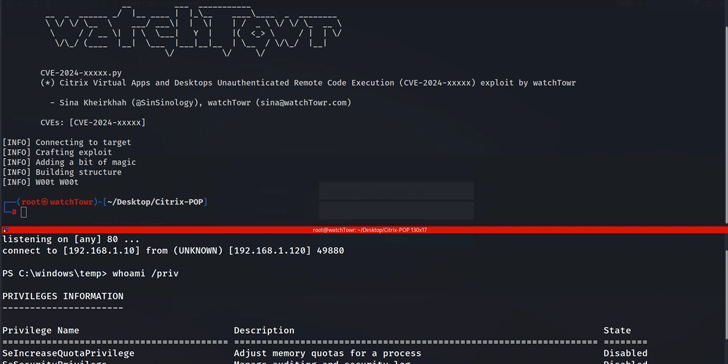PAN-OS Firewall Vulnerability Under Active Exploitation – IoCs Released
Palo Alto Networks’ disclosure of a new zero-day vulnerability affecting its PAN-OS firewall management interface is critical for organizations using their products. The active exploitation of this vulnerability in the wild highlights the need for immediate attention to security measures and vigilance.
To mitigate potential threats, administrators should:
- Ensure the PAN-OS management interface is not exposed to the public internet unless absolutely necessary.
- Implement IP-based access control lists to limit access to trusted sources.
- Monitor traffic for signs of access from the known malicious IP addresses:
- 136.144.17[.]*
- 173.239.218[.]251
- 216.73.162[.]*
Palo Alto Networks’ latest update on the zero-day vulnerability in its PAN-OS firewall management interface reveals critical details about its nature and the active exploitation it has seen:
- Nature of the Vulnerability: This yet-to-be-named flaw, with a high CVSS score of 9.3, is rated as critical due to its ability to allow unauthenticated remote command execution. The attack requires no user interaction or prior privileges and is classified as having low complexity, making it accessible for attackers to leverage.
- Exploitation and Impact: The vulnerability is actively being used to deploy web shells on compromised devices, granting attackers persistent remote access. Despite this, Palo Alto Networks has cautioned that the listed IP addresses associated with the malicious activity could be legitimate third-party VPNs, which might complicate straightforward threat analysis.
- Severity Reduction: While the vulnerability carries a critical CVSS score in its default state, restricting access to the management interface to a limited set of IP addresses can lower the severity to a high score of 7.5. In such cases, attackers would need privileged access to those IPs to exploit the flaw.
- Advisories and Recommendations:
- November 8, 2024 Advisory: Palo Alto Networks began recommending that customers secure their firewall management interfaces following reports of the remote code execution (RCE) vulnerability.
- Mitigation Measures: Users should restrict management interface access, monitor for suspicious activity, and apply IP-based restrictions to enhance security.
- Non-Affected Products: The flaw does not impact Prisma Access and Cloud NGFW products.
Given that patches for the new zero-day vulnerability in the PAN-OS firewall management interface are still pending, it is crucial for users to take immediate, proactive steps to secure their systems. This involves:
- Restricting Access: Limiting the management interface access to trusted IPs and ensuring it is not exposed to the public internet.
- Monitoring Traffic: Keeping a close watch on network traffic for signs of activity from known suspicious IP addresses, as well as for unusual behavior indicative of web shell deployment.
Context of Recent Threats: This advisory coincides with the active exploitation of three separate critical vulnerabilities in the Palo Alto Networks Expedition tool:
- CVE-2024-5910
- CVE-2024-9463
- CVE-2024-9465
These vulnerabilities have been highlighted by the U.S. Cybersecurity and Infrastructure Security Agency (CISA). While there is no evidence linking these issues to the PAN-OS zero-day vulnerability, their simultaneous exploitation underscores the heightened threat environment facing Palo Alto Networks users.
Recommendations for Users:
- Apply IP-based restrictions and network segmentation to limit exposure.
- Regularly audit and strengthen firewall management configurations.
- Follow Palo Alto Networks’ guidance and CISA advisories closely for further updates and patch releases.
Maintaining vigilance and implementing these interim measures is essential to safeguarding systems until official patches are available.
Technical Details:
- Zero-Day Vulnerability in PAN-OS Management Interface
- CVSS Score: 9.3 (Critical)
- Type: Remote Code Execution (RCE)
- Details:
- Allows unauthenticated remote command execution.
- Exploitable with low attack complexity and requires no user interaction or privileges.
- Mitigation:
- Restricting the management interface to a limited set of IP addresses can reduce the CVSS score to 7.5 (High), as it adds the requirement for attackers to have privileged access to those IPs.
- Status: No CVE identifier assigned yet.
- Impact: Used to deploy web shells, granting persistent remote access to threat actors.
- Current Situation: No patch available; users must secure access manually.
- Exploited Vulnerabilities in Palo Alto Networks Expedition Tool
These three vulnerabilities have been noted by the U.S. Cybersecurity and Infrastructure Security Agency (CISA) as under active exploitation:
- CVE-2024-5910:
- Severity: Critical
- Details: Specifics on the nature of the vulnerability (e.g., type and attack vectors) are pending additional details from advisories.
- CVE-2024-9463:
- Severity: Critical
- Details: Exploited in the wild, but further information on attack mechanics is yet to be fully disclosed.
- CVE-2024-9465:
- Severity: Critical
- Details: Details about its exploitation and mitigation steps are being monitored and shared by security agencies like CISA.
Indicators of Compromise (IoCs)
IP Addresses Associated with Malicious Activity:
- 136.144.17[.]*
- 173.239.218[.]251
- 216.73.162[.]*
These IP addresses have been observed in connection with attempts to exploit the PAN-OS management interface. However, Palo Alto Networks has cautioned that these addresses might include legitimate activity from third-party VPNs, so further investigation and contextual analysis are necessary when these IPs are detected in network logs.
Potential IoCs for Web Shell Deployment:
- Unusual Traffic Patterns: Watch for unexpected or repeated access attempts to the management interface, especially from the mentioned IP addresses.
- New or Unexpected Files: Monitor for new or unknown scripts or web shell files on the device’s file system.
- Persistence Indicators: Look for changes to startup configurations or scheduled tasks that could indicate attempts to maintain access.
Monitoring IoCs:
- Log Analysis: Review and analyze logs from firewalls, intrusion detection systems (IDS), and web servers for signs of suspicious activities related to these IPs.
- Network Monitoring: Employ network traffic analysis tools to detect unusual communication patterns or connections to known malicious IP addresses.
- File Integrity Monitoring: Use tools that can detect unexpected changes to files on critical systems to identify potential web shell installations.
Impact:
- Security Risks:
- Remote Code Execution (RCE): The vulnerability allows threat actors to execute arbitrary commands remotely without authentication, leading to potential full control of affected systems.
- Web Shell Deployment: Exploitation of the flaw enables attackers to install web shells, granting persistent remote access and facilitating further malicious activities, such as data exfiltration, lateral movement within networks, or deployment of additional malware.
- No User Interaction Needed: The vulnerability does not require any user interaction or pre-existing privileges, making it straightforward for attackers to exploit.
- Severity Level:
- CVSS Score: 9.3 (Critical). The vulnerability’s default state carries a critical risk due to its ease of exploitation and potential impact.
- Access Limitation Impact: When access to the management interface is restricted to a limited set of IPs, the CVSS score drops to 7.5 (High). While this reduces the risk, it still poses a significant threat if attackers manage to compromise the allowed IPs.
- Operational Impact:
- Business Disruption: Successful exploitation could lead to service interruptions, data breaches, or loss of control over critical network infrastructure.
- Financial Losses: Organizations may face costs associated with incident response, data recovery, potential regulatory fines, and reputational damage.
- Increased Security Monitoring: The threat demands enhanced security measures, consuming time and resources to monitor and mitigate risks.
- Scope of Exposure:
- Global Reach: Any organization using Palo Alto Networks firewalls with exposed management interfaces is at risk.
- Type of Targets: While the specific targets of these attacks are not detailed, any entity relying on PAN-OS for critical network security—including enterprises, government agencies, and service providers—could be impacted.
- Current Status:
- No Patch Yet: With patches yet to be released, organizations are temporarily reliant on manual mitigation strategies, such as restricting access and closely monitoring for IoCs.
- Limited Number of Exploited Cases: Palo Alto Networks has stated that the exploitation has affected a “limited number” of instances so far, indicating targeted attacks but with potential for broader impact if not addressed.
- Exclusions:
- Prisma Access and Cloud NGFW: These products are not affected by this particular vulnerability, narrowing the scope of affected systems.
Recommendations:
- Restrict Access to the Management Interface:
- Limit the PAN-OS management web interface to a specific set of trusted IP addresses.
- Ensure the interface is not accessible from the public internet wherever possible.
- Monitor for IoCs:
- Watch for traffic from known suspicious IP addresses:
- **136.144.17[.], 173.239.218[.]251, 216.73.162[.].
- Analyse network and firewall logs for unusual activity that could indicate an attempted or successful exploit.
- Watch for traffic from known suspicious IP addresses:
- Implement Web Application Firewalls (WAFs):
- Deploy WAFs to help filter and block malicious traffic to the management interface.
- Enhance Logging and Alerting:
- Enable detailed logging on all PAN-OS management interfaces.
- Set up alerts for signs of unauthorized access attempts, web shell deployments, and unexpected file changes.
- Segregate Network Segments:
- Isolate the management interface from the main network and critical systems to minimize lateral movement in case of compromise.
Mid- to Long-Term Recommendations:
- Apply Patches and Updates:
- Continuously monitor for updates from Palo Alto Networks and apply patches as soon as they are available to remediate the vulnerability.
- Strengthen Access Controls:
- Implement multi-factor authentication (MFA) for accessing the management interface.
- Use strong, unique passwords for administrative accounts and enforce password rotation policies.
- Review and Harden Firewall Configurations:
- Regularly audit firewall rules and management configurations to ensure they adhere to best practices and are up to date.
- Implement Network Security Monitoring:
- Deploy intrusion detection and prevention systems (IDS/IPS) that can identify and block exploit attempts in real time.
- Educate IT and Security Teams:
- Provide training to staff on recognizing signs of compromise and effective incident response procedures.
- Update incident response playbooks to include steps specific to potential exploitation of the PAN-OS management interface.
- Conduct Regular Vulnerability Assessments:
- Perform security audits and vulnerability scans to identify and address any potential weaknesses in the network.
- Establish a Secure VPN for Remote Access:
- Ensure that remote access to management interfaces is only available through a secure VPN, limiting potential points of exposes
- Backup and Recovery Plans: Ensure regular backups of firewall configurations and maintain a tested recovery plan in the event of a breach.
- Collaborate with Security Vendors: Stay informed through advisories from Palo Alto Networks and relevant cybersecurity agencies like CISA.
- Update Incident Response Plans: Make sure your organization’s incident response plan includes clear steps for handling zero-day vulnerabilities and external advisories.



